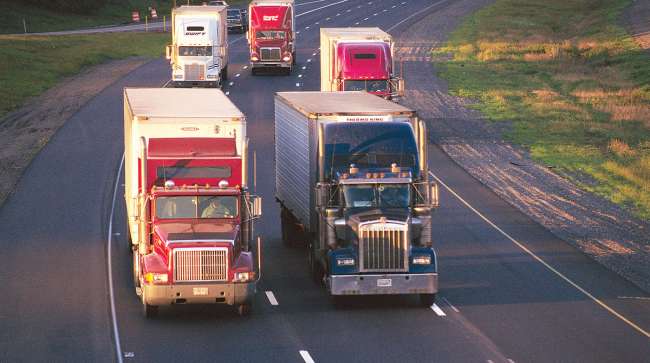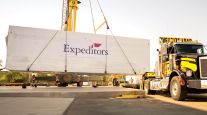Staff Reporter
Digital Freight Sector Responds to Coronavirus Outbreak

[Stay on top of transportation news: Get TTNews in your inbox.]
Digital freight companies are taking a proactive approach to confronting the coronavirus as the outbreak worsens.
“This outbreak has been massively disruptive for the American economy and we, like many others, everyone in the freight industry right now, is figuring out and responding to it,” Convoy economist Aaron Terrazas told Transport Topics. “There has been this surge of freight demand and the freight industry, as it often does during these national emergencies, is pulling off real feats in delivering goods that American consumers are buying in large quantities right now.”
Digital freight companies have had to contend with significant disruptions throughout the supply chain, including a surge of activity as consumers stockpile necessities.

Terrazas
At the same time, ports have struggled, and major contributors such as China have been hit hard.
“As far as our business, we’re seeing a surge in truckload demands, particularly for those consumer goods,” Terrazas said. “There are a number of routes that are seeing record traffic through our network. Of course, there are so many unknowns in terms of how long that will last and what happens after the surge, particularly as the shutdowns and closures become more widespread.”
Jim Nicholson, vice president of carrier sales and operations at Loadsmart, has seen outbound tender volumes exceed 2018 numbers while spot market postings are approaching that record-setting year. But, he warned, quarantine activity could delay a concurrent rebound in imports into the second or even third quarter.
“On the supply side, although capacity has increased since 2018, with the soaring load volumes, it’s quickly being absorbed and becoming harder to find a carrier quickly,” Nicholson told TT. “Tender rejections have more than doubled since the beginning of March and are continuing to rapidly climb.”
Nicholson added that while certain retailers are surging to keep up with the increased demand, he warns other industries are susceptible to the quarantine measures. He spoke with experts in the automotive sector who noted volumes have begun to deteriorate as concerns mount.
“If we experience an import rush, this will stress infrastructure and will impact full truckload capacity outbound from Southern California, similar to the pre-tariff import rush experienced in peak 2018-early 2019,” NEXT Trucking co-founder and CEO Lidia Yan told TT.
As of March 24, there were more than 409,000 diagnosed cases of COVID-19 worldwide, according to the Center for Systems Science and Engineering at Johns Hopkins University. More than 50,200 cases had been confirmed in the U.S., with at least 600 deaths.
“While domestic truckload trends are strong, port activity continues to suffer,” Nicholson said. “Production in China ranges from 50% to 90% based on industry and region, but is beginning to improve. We believe a full return in Chinese manufacturing and production is likely in the coming weeks.”

Seroka
Los Angeles and Long Beach port terminals are canceling work shifts due to blank sailings. Port of Los Angeles Executive Director Gene Seroka has said overall import volumes are weak with total shipments at the port being down 23% for February.
“This mirrors what NEXT has seen at the ports, though the impact to our drayage trucking business has not been as drastic as what the L.A. ports are seeing in terms of the drop in shipment volume,” Yan said. “That being said, we are anticipating volumes to pick up significantly in late April-May as production comes back online in Asia, specifically China.”
Yan added that a growing concern for both terminals and drayage trucking companies is what is known as “the empty problem.” That refers to the growing number of empty shipping containers resulting from limited terminal space and outbound vessel sailings.
“The empty containers must be stored at terminals, warehouses or trucker yards,” Yan said. “NEXT has started to see the empty backlog grow as terminals reduce empty return appointments or refuse acceptance. NEXT’s multiple yards have become increasingly important in light of this growing backlog.”

Yan
Yan added that terminals are not able to accept all of the empties being returned due to space. The growing empty container backlog also could lead to a chassis shortage as the majority of empties are sitting on chassis. She also expects steamship lines are likely to face steep losses due to vessels sitting idle.
“Being a digital freight network and having so many of our processes automated has made the transition relatively seamless for us,” Terrazas said. “We are seeing a surge in demand like everyone else, but because we have so many of these processes automatically going through, they often happen without a hitch.
“That’s not to say everything is going perfectly smoothly. We get reports from some of our drivers of long waits at facilities, and that’s unfortunately something technology isn’t going to perfectly fix.”
Uber Freight on March 23 announced a series of initiatives to support carriers and keep essential goods moving. All relief loads booked through the platform will be hauled with zero profit pricing. Truck drivers using the app also will receive a weekly $20 credit toward Uber Eats. Uber Freight also will be providing thousands of sanitation kits to small carriers using the app.
To aid carriers + shippers during this time:
✔ Drivers delivering UF loads will get weekly @UberEats credits
✔ We’ll give small carriers cleaning supplies for their trucks
✔ UF will take 0% profit on emergency relief shipper platform loadshttps://t.co/mtlk9tZfqN — Uber Freight (@UberFreight) March 24, 2020
“The freight industry is the lifeblood of the economy,” Uber Freight said in a statement. “In this time of crisis, Uber Freight remains committed to supporting our carriers and our shipper partners by providing 24/7 service and support, and keeping our operations running strong.”
Uber Freight said zero profit pricing will lower the cost of transportation to help small shippers navigate the current economic challenges and ensure that critical goods are moving. The policy will remain in effect as the FMCSA hours-of-service suspension continues.
Want more news? Listen to today's daily briefing:



